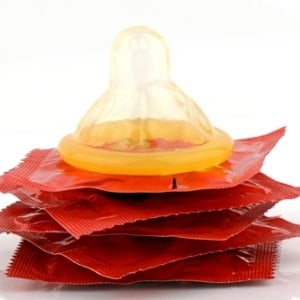
Rushing to put on a condom may lead to problems that raise the risk of sexually transmitted infections, according to a new study.
Breaks, leaks and slips
Survey responders, almost 60 percent of them women, were more likely to report condom breaks, leaks and slips when it was put on in a hurry, researchers found. Couples who rushed were also more likely to report not using a condom for the entire sex act.
"The message is take your time," said Dr. Lydia Shrier. "If you're going to be using the condom, use it correctly so you avoid the type of problems we reported on."
Read: Condoms
Previous research into condom problems were limited by having asked mostly men about their last sexual experiences, said Shrier, of Boston Children's Hospital and Harvard Medical School, the study's senior author.
The new study used data collected from 2007 through 2011 from 512 men and women who sought treatment at five U.S. health clinics with reputations for diagnosing and treating sexually transmitted infections.
The participants, whose ages ranged from 15 through 65, recorded their sexual encounters in an online diary for up to 180 days. In total, the data covered 8,856 instances of vaginal sex between men and women that included condoms.
In about 7 percent of those sexual encounters, the participants reported being rushed while putting on the condoms.
Whole range of problems
Overall, the condom broke, slipped off and leaked about 5 percent of the time when people rushed to put it on, compared to about 2 to 3 percent of times when they didn't rush.
Additionally, 22 percent of people who were rushed while putting on a condom reported not using the condom throughout sex, compared to about 14 percent of people who were not rushed.
"I think that this study demonstrates that being rushed when putting a condom on can produce a whole range of problems with a condom," Shrier said.
Read: French need biggest condoms
The U.S. Centers for Disease Control and Prevention (CDC) says that consistent and correct use of condoms reduces the risk of infections such as Chlamydia and gonorrhoea that are transmitted by sexual fluids. It also reduces the risk of ulcer conditions, such as herpes.
Consistent and correct use is also effective at reducing the risk of acquiring HIV, the virus that causes AIDS, according to the CDC. It may also reduce the risk of human papillomavirus (HPV), which may cause genital warts and cervical cancer.
"It works really well to prevent sexually transmitted infections when it's used correctly and consistently," Shrier said.
She said people should be taught to take time and focus while putting on condoms to prevent the types of errors they found in this study.
"Until we overcome all of those hurdles, condoms can't really work to prevent disease," Shrier said.
SOURCE: http://bit.ly/11uByuY Sexually Transmitted Infections, online November 12, 2014.
Read more:
Improper condom use puts gay men at increased HIV risk
Giant pink condom rolled out in Sydney
South Africans not faithful and not using condoms
Image: Stack of condoms from Shutterstock




 Publications
Publications
 Partners
Partners














